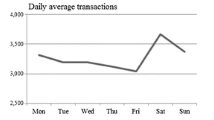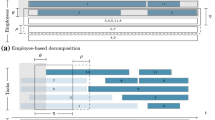Abstract
This paper is concerned with the problem of assigning employees to gas stations owned by the Kuwait National Petroleum Corporation (KNPC), which hires a firm to prepare schedules for assigning employees to about 86 stations distributed all over Kuwait. Although similar employee scheduling problems have been addressed in the literature, certain peculiarities of the problem require novel mathematical models and algorithms to deal with the specific nature and size of this problem. The problem is modeled as a mixed-integer program, and a problem size analysis based on real data reveals that the formulation is too complex to solve directly. Hence, a two-stage approach is proposed, where the first stage assigns employees to stations, and the second stage specifies shifts and off-days for each employee. Computational results related to solving the two-stage models directly via CPLEX and by specialized heuristics are reported. The two-stage approach provides daily schedules for employees for a given time horizon in a timely fashion, taking into consideration the employees’ expressed preferences. This proposed modeling approach can be incorporated within a decision support system to replace the current manual scheduling practice that is often chaotic and has led to feelings of bias and job dissatisfaction among employees.
Similar content being viewed by others
References
Abdennadher, S., & Schlenker, H. (1999). Nurse scheduling using constraint logic programming. In Proceedings of the 11th conference on innovative applications of artificial intelligence (pp. 838–843).
Alfares, H. (2004). Survey, categorization, and comparison of recent tour scheduling literature. Annals of Operations Research, 127, 145–175.
Al-Yakoob, S. M., & Sherali, H. D. (2006). A column generation approach to an employee scheduling problem. Journal of the Operational Research Society, 1–10.
Bard, J., Binici, C., & de Silva, A. (2003). Staff scheduling at the United States postal services. Computers and Operations Research, 30(5), 745–771.
Bechtold, S. (1988). Implicit optimal and heuristic labor staffing in a mutiobjective, multilocation environment. Decision Sciences, 19(2), 353–373.
Brusco, M., & Jacobs, L. (2001). Starting-time decisions in labor tour scheduling: an experimental analysis and case study. European Journal of Operational Research, 131, 459–475.
Burke, E. K., De Causmaecker, P., Vanden Berghe, G., & Van Landeghem, H. (2004). The state of the art of nurse rostering. Journal of Scheduling, 7, 441–499.
Carter, M., & Lapierre, S. (2001). Scheduling emergency room physicians. Health Care Management Science, 4, 347–360.
Eitzen, G., Mills, G., & Panton, D. (2004). Multi-skilled workforce optimization. Annals of Operations Research, 127, 359–372.
Ernst, A. T., Jiang, H., Krishnamoorthy, M., Owens, B., & Sier, D. (2004a). An annotated bibliography of personnel scheduling and rostering. Annals of Operations Research, 127, 21–144.
Ernst, A. T., Jiang, H., Krishnamoorthy, M., & Sier, D. (2004b). A review of applications, methods, and models. European Journal of Operational Research, 153, 3–27.
Sherali, H. D. (1982). Equivalent weights for lexicographic multiple objective programs: characterization and computations. European Journal of Operational Research, 11(4), 367–379.
Sherali, H. D., & Al-Yakoob, S. M. (2006a). Determining an optimal fleet mix and schedules: Part I—single source and destination, In J. Karlof (Ed.), Integer programming: theory and practice (pp. 137–166). London: Taylor and Francis.
Sherali, H. D., & Al-Yakoob, S. M. (2006b). Determining an optimal fleet mix and schedules: Part II—multiple sources and destinations, and the option of leasing transshipment depots, In J. Karlof (Ed.), Integer programming: theory and practice (pp. 167–193). London: Taylor and Francis.
Topaloglu, S. & Ozkarahan (2004). An implicit goal programming model for the tour scheduling problem considering the employee work preferences. Annals of Operations Research, 128, 135–158.
Valouxis, C., & Housos, E. (2000). Hybrid optimization techniques for the workshift assignment of nursing personnel. Artificial Intelligence in Medicine, 20(2), 155–175.
Author information
Authors and Affiliations
Corresponding author
Rights and permissions
About this article
Cite this article
Al-Yakoob, S.M., Sherali, H.D. Mixed-integer programming models for an employee scheduling problem with multiple shifts and work locations. Ann Oper Res 155, 119–142 (2007). https://doi.org/10.1007/s10479-007-0210-4
Published:
Issue Date:
DOI: https://doi.org/10.1007/s10479-007-0210-4




